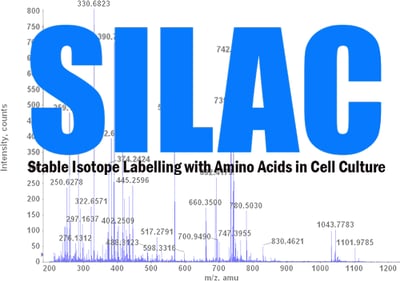SILAC (Stable Isotope Labeling with Amino Acids in Cell Culture)
 Quantitative proteomics has been a cutting-edge and demanding field in biological research for the past few decades. With the advancement of technology, MS (Mass spectrometry) based methods have become strikingly helpful tools, which utilize the mass-to-charge ratio of the fragmented compound in proportion with its ionic abundance. MS provides the result as a plot of ionic abundance of a compound versus its mass-to-charge ratio, which subsequently provides information about the nature, possible structure and properties of the compound. This compound could be any protein, posttranslational modification, bioactive molecules etc. The MS responses of proteolytic peptides may discreetly vary owing to their non-uniform physicochemical properties for example, hydrophobicity, dipole moment, size, charge, mass etc. Hence it becomes a strenuous exercise to accurately quantify the changes in the relative abundance of a biomolecule between different test samples in the same MS analysis. To solve this pitfall, a new modification has been introduced in the general MS protocol known as SILAC (Stable Isotope Labeling with Amino Acids in Cell Culture), which allows insertion of stable isotopes of amino acids into the proteins or peptides. SILAC enables relative and comparable quantification of these molecules from different test samples in the same MS run, which eventually minimize the false variability of the results arising from sample injection and ion suppression contributed by MS instruments in different runs.
Quantitative proteomics has been a cutting-edge and demanding field in biological research for the past few decades. With the advancement of technology, MS (Mass spectrometry) based methods have become strikingly helpful tools, which utilize the mass-to-charge ratio of the fragmented compound in proportion with its ionic abundance. MS provides the result as a plot of ionic abundance of a compound versus its mass-to-charge ratio, which subsequently provides information about the nature, possible structure and properties of the compound. This compound could be any protein, posttranslational modification, bioactive molecules etc. The MS responses of proteolytic peptides may discreetly vary owing to their non-uniform physicochemical properties for example, hydrophobicity, dipole moment, size, charge, mass etc. Hence it becomes a strenuous exercise to accurately quantify the changes in the relative abundance of a biomolecule between different test samples in the same MS analysis. To solve this pitfall, a new modification has been introduced in the general MS protocol known as SILAC (Stable Isotope Labeling with Amino Acids in Cell Culture), which allows insertion of stable isotopes of amino acids into the proteins or peptides. SILAC enables relative and comparable quantification of these molecules from different test samples in the same MS run, which eventually minimize the false variability of the results arising from sample injection and ion suppression contributed by MS instruments in different runs.
SILAC was first introduced in 2002, as a metabolic labeling technique in the Centre for Experimental Bioinformatics (CEBI) at the University of Southern Denmark. Precisely, stable isotope-labelled amino acids are used in the growth medium of the live cells, subsequently allowing a wide comparison of the cellular proteomics in different experimental conditions.
Principles of SILAC
SILAC is essentially based on the metabolic incorporation of stable isotope labelled amino acids, such as arginine or lysine containing 13C or 15N into the live cell cultures. There are two populations of cells chosen and grown in two distinct media; one population with "light medium" essentially comprising natural isotope containing amino acids, while the other population is fed with "heavy medium" comprising stable isotope labelled amino acids.
The key principle behind SILAC is increase in metabolic activities with the number of cell divisions, subsequently increased incorporation of amino acids into the proteome. With the number of divisions, the proteins reach to a heavy state where all the proteins contain labelled amino acids. Although, the labeling efficiency is subjected to prior optimization depending on the protein turnover rate (protein synthesis versus degradation). After ensuring complete labeling (equal to or >95% labeling efficiency), the cell populations can be subjected to manipulation, followed by extraction of total proteins from the equal population of labelled and unlabeled cells. The protein samples are probed to trypsin based digestion forming peptides. Eventually the digested peptides can be analyzed on LC-MS/MS instrumentation. The quantification of the results is based on the ratio of isotope-labelled peptides to unlabeled peptides. The signal intensities from labelled and unlabeled samples allow quantitative comparison.
For conducting SILAC experiments, the choice of amino acids is very crucial. In ideal conditions, these amino acids should be the one essential for cell survival in a culture system to ensure that the only source of the chosen amino acid is from the culture medium for e.g., Leucine, lysine, and methionine.
These days, the combination of 13C or 15N- labelled arginine and lysine is used in the heavy medium as the proteolytic enzyme, Trypsin, used in the next step for the proteomics analysis cleaves specifically at the carboxyl-termini of lysine and arginine residues. Therefore, a combination SILAC labeling with heavy lysine and arginine with the combination of trypsin digestion provides a greater degree of quantitation of majority of tryptic peptides in a protein except the C-terminus, eventually culminate into higher efficiency of proteomic quantification.
Multiplexed level of comparison of SILAC
SILAC experiments can be performed with two or more levels (plexes) of comparison. Majority of the experiments compare two different cellular conditions. However, with the availability of three isotopically distinct forms of arginine and lysine, it is also possible to perform three levels of comparison. Most recently, with wide advantages of multiple levels of comparison, 5-plex SILAC experiments can be used with five isotopically distinct forms of arginine. Although the drawback of 5-plex system is the compromisation with the quantification efficiency of the proteome as only the arginine-containing peptides can be quantified with this. In order to overcome this problem, two 3-plex SILAC labelling can be performed with in the same test condition.






